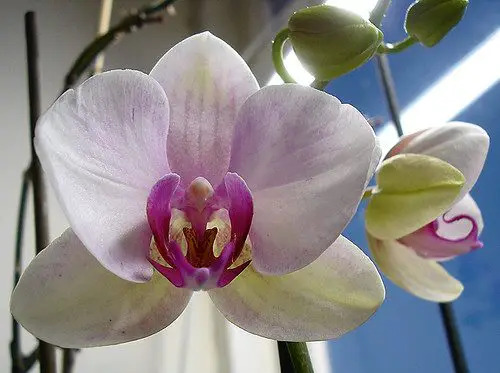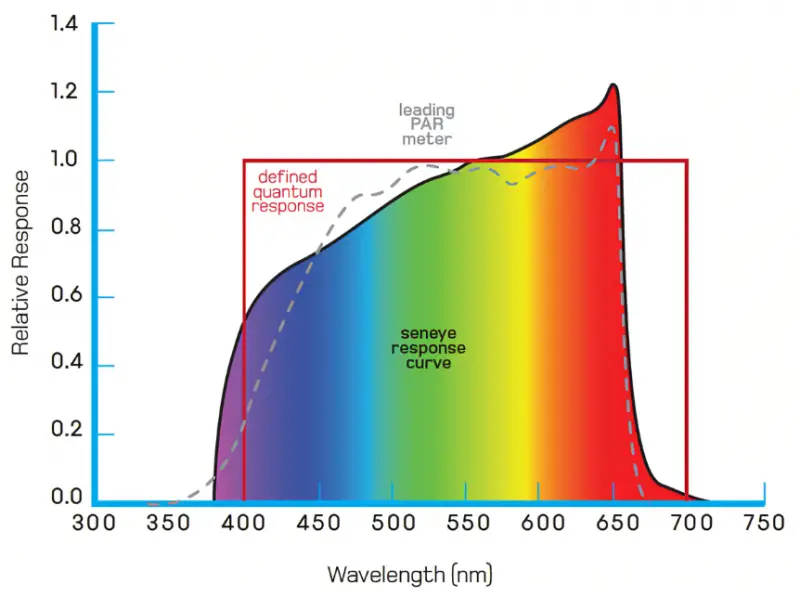Providing the right lighting for orchids indoors is one of the most important aspects of growing orchids indoors.

The right type and amount of light will ensure that your plants thrive and produce beautiful blooms.
Lighting For Orchids Indoors
There are several types of lights that can be used for growing orchids. Fluorescent lights have been used for years.
Some growers have used CFL lights which are very similar to fluorescent lights. HID lighting like metal halides has also been used.
The best grow lights for orchids at this time are full-spectrum LED lights. They provide a spectrum very close to natural sunlight.
They produce much less heat than other lighting methods. They also produce more light per watt of electricity used.
You see all lights produce heat in the process of making light but the more heat they give off the less efficient they are at making light.
While I am not going to try and sell you a LED grow light, I am recommending that you buy one for your orchids.
Ideally, it will be full-spectrum and have a dimmer.
As to wattage, you need to check the wattage at the wall and not the number manufacturers give you.
The size you will need will depend on the area you want to light and how much light your plants need.
If you undersize your plants may not get enough light but if you oversize a bit you can use your dimmer to tone things down.
This is why it is generally better to buy an LED light that is a bit bigger than you think you will need.
It will be important to understand how much light your orchids need and have a way to measure light intensity.
Here is a related article you may find helpful: Do Orchids Need Direct Sunlight? – Hydroponic Orchids
Light Requirements for Indoor Orchids
In this video, we’ll learn everything we need to know about lighting for indoor orchids.
We’ll discuss the different types of lights available, how to measure light intensity, and what to look for when choosing lights for your orchid collection.
This is a long and very thorough video that will tell you just about anything you need to know about lighting for orchids indoors.
By the end of this video, you’ll be an expert on indoor lighting for orchids!
Here is a link to the article Amanda Matthews wrote: https://orchideria.com/orchid-light-requirements/
A few caveats, this video is a bit older, and red and blue or blurple LED lights have been replaced by full-spectrum “white LEDs.”
Also, research shows that plants do indeed absorb green light. White light is actually a combination of all the colors a plant uses.
LED lighting is not measured in foot candles but by PAR. It stands for Photosynthetically Active Radiation which is measured in micromoles (µmoles).
And this is the measure of the amount of light (photons) plants use from the wavelengths between 400 and 700 nanometers.

Par meters are not cheap and there are apps you can add to your smartphone that will measure par but they are not always accurate.
You can use a light meter and there are ways to convert it to par but again they are not as accurate as using a par meter.
Lighting Requirements For Orchids Indoors
Not all orchids need the same amount of light. There are thousands of different orchid species growing over a large geographic area.
So some orchids will tolerate more sun or higher light levels. For most orchids direct sunlight is harmful.
But even growing indoors under lights you can give some orchids too much light.
So it is important to know if your orchid needs high, medium, or low light.
Phalaenopsis or moth orchids are probably one of the most common orchids people have.
Chances are if you picked up an orchid at a supermarket or were gifted one it is a Phalaenopsis. They are low-light orchids.
Here is a chart I found online that you can use as a guide for providing the right lighting for orchids indoors.
Converting Foot Candles To PPFD
A lot of information online is older and they use foot candles to measure light.
If you are using LED lights you will need to convert foot candles to PPFD (Photosynthetic Photon Flux Density )
This measures the amount of light that actually is at the top of the crop canopy. Most LED manufacturers will provide this number.
Once you have your PPFD number you can convert from foot candles. https://www.apogeeinstruments.com/conversion-ppfd-to-foot-candles/

Light Requirements by Genus
Below find light requirements recommended by the American Orchid Society:
Cattleya –Medium to High
Cymbidium –Medium to High
Dendrobium –Medium to High
Masdevallia –Low to Medium
Miltonia –Medium
Odontoglossum –Medium
Oncidium –Medium to High
Paphiopedilum –Low to Medium
Phalaenopsis –Low to Medium
Vanda –Medium to High
Low Light = 1,000 2,000 foot-candles, two hours of filtered sunlight per day, 14 hours of fluorescent light within 8 inches of the tubes. These plants can be grown indoors under indirect light or outdoors under shade.
Medium Light = 2,000 3,000 foot-candles, four hours of sunlight per day, 16 hours of fluorescent light within 6 inches of the tubes. Outside, moderately sunny windows or under lights would be suitable.
High Light = 3,000 4,000 foot-candles, six hours of sunlight per day, within 3 inches of tubes, near the center of the fixture. In a sunny window or outdoors would be ideal for these plants.
Foot candles is a standard measure of light for plants and can be determined with a light meter.
Source: Your First Orchid, AOS, Stephen R. Batchelor
https://www.gardenweb.com/discussions/2766316/light-requirements-by-genus
Final Thoughts On Lighting For Orchids Indoors
Now that you know all about indoor lighting for orchids, you can choose the right lights for your plants and ensure that they thrive.
Remember to consider the intensity of the light, the type of light, and the color of light when making your purchase.
With the proper lighting, I’m sure your orchids will be healthy and beautiful!
Read more: Are Orchids Hard To Take Care Of? Easy Growth Formula
This post contains affiliate links.

